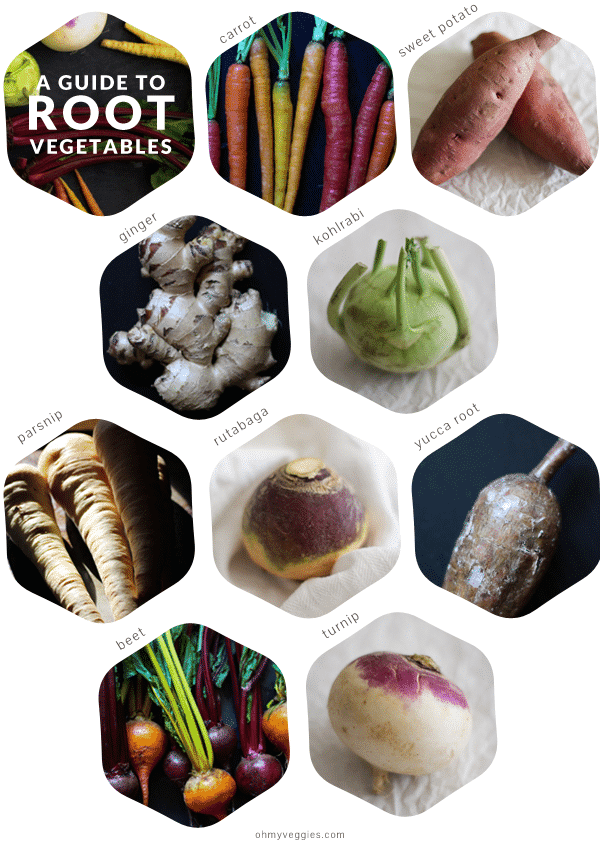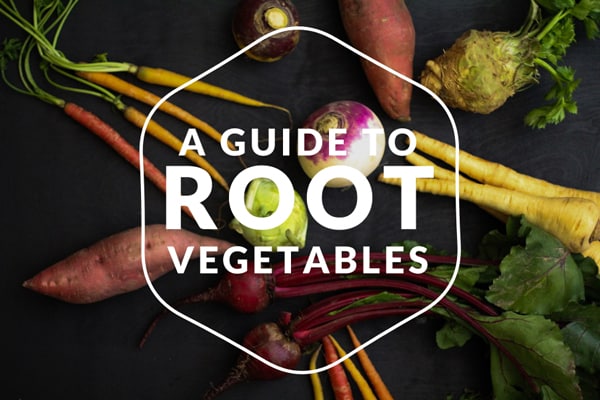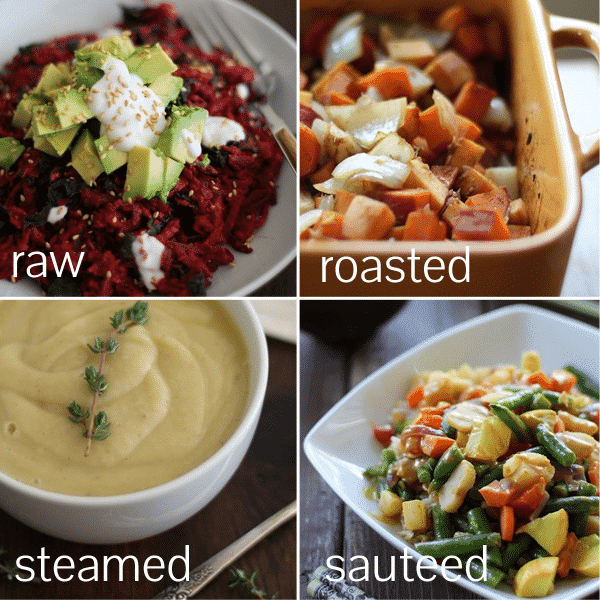Truth: root vegetables can be intimidating. Most of them have thick, strange looking skin and long stems with leaves sprouting out of them. Let’s face it, some of them look like they’re from outer space.
Some root vegetables are given the cold shoulder because they have the reputation of tasting earthy and even bitter. But hold the phone.
This guide to root vegetables can serve as inspiration to embrace those outcast extraterrestrial roots, as they are not only amazing for your health, but they are versatile in the kitchen and absolutely delicious when prepared properly.
Jump to:
The Health Benefits of Root Vegetables
Roots are some of the most nutrient-dense vegetables in the world. While each root contains its own set of health benefits, they share many of the same characteristics.
Yams, beets, parsnips, turnips, rutabagas, carrots, yuca, kohlrabi, onions, garlic, celery root (or celeriac), horseradish, daikon, turmeric, jicama, Jerusalem artichokes, radishes, and ginger are all considered roots.
Because root vegetables grow underground, they absorb a great amount of nutrients from the soil. They are packed with a high concentration of antioxidants, Vitamins C, B, A, and iron, helping to cleanse your system.
They are also filled with slow-burning carbohydrates and fiber, which make you feel full, and help regulate your blood sugar and digestive system.
This factor, plus the high-octane nutrients and low calories, make rot veggies excellent for people who are trying to lose weight, or simply stay healthy.
Root vegetables are disease-fighting, immunity and energy-boosting, and are also extremely versatile in cooking.
What is the Best Season for Root Vegetables?
Most root vegetables are available year round, but their peak season is fall through spring, with the exception of beets, which are best summer through fall. When in-season, roots have a deeper, sweeter flavor and tend to be juicier, but they are one of those plants that seem to stay consistently great all year long.
How Do You Choose Roots?
Selecting good root vegetables is the opposite of selecting good fruit - the harder, the better. They should be smooth and free of gashes or bruises. When choosing roots that come with leafy greens (a bunch of beets, for example), make sure the stems and leaves of the greens are firm and bright.
How Do You Store Root Vegetables?
While you certainly don’t need to have a root cellar to purchase and enjoy root vegetables, they are best stored in a cool, dark, humid room. When storing them in the refrigerator, keep roots in a paper or plastic bag in the crisper. Storing them uncovered causes them to soften and go bad quickly.
What Are the Types of Root Vegetables?
There are almost too many to mention here! These are some of my favorites to cook with:
Sweet Potatoes & Yams
Among the most usable, user-friendly, and palatable, sweet potatoes and yams are great mashed, pureed and made into soup, roasted, and baked into muffins, cookies, pancakes and so much more.
They can be used both in sweet and savory applications and are very well-matched with coconut milk, honey, maple syrup, orange, cinnamon, ginger, pecans, cashews, walnuts, raisins, and curry powder.
Yams are often confused with sweet potatoes, and although they can be used interchangeably, there is a slight difference.
Some of my favorite sweet potato recipes are these brown butter mashed sweet potatoes and this Thai red curry with pineapple and sweet potato.
Beets
Touted as a superfood, beets are among the healthiest foods on the planet. They’re full of beta-carotene and betalains, which are antioxidants and anti-inflammatory.
Beets have an earthy, sweet flavor, and are best when roasted (see how to roast beets here), steamed, or left raw and shredded.
Golden beets are typically slightly sweeter than red beets. I find citrus (particularly oranges or clementines), blueberries, goat cheese, walnuts, ground cumin, cinnamon, and tahini are excellent compliments for beets. This Roasted Beet & Fig Salad is one of my go-to recipes, and this Roasted Beetroot Napoleon is one of my favorite dinner party recipes.
Parsnips
Parsnips have a cinnamon-y flavor and resemble large white carrots (or albino carrots, as I like to call them). They are harder than carrots and have a deeper, warm flavor.
I find parsnips are best used in soups, pureed into a mash, or shredded thinly for parsnip latkes. Parsnips are complimented by nutmeg, cream, and thyme.
Turnips
While turnips are versatile, they are very subtle in flavor, which makes them great for pairing with more strongly flavored vegetables. They are great roasted, sautéed, or included in vegetable stir fry. You can also combine turnips with herbs, or use them in tomato-based chunky soups or creamy pureed soups.
Rutabagas
Similar to turnips, rutabagas are subtle in flavor. They are harder than turnips and taste a bit more earthy. Best when pureed or roasted, rutabagas go well with herbs, particularly dill, as well as lime and Indian spices. They're delicious in these One Pot Lentils and Rice.
Carrots
Crisp and sweet, carrots are perhaps the most popular root vegetable because they are perfect for eating raw. They match well with just about any vegetable in both cooked and raw applications and can be paired with any spice or herb. They're even delicious in baked goods, like these vegan carrot muffins.
Yuca Root
Starchy and subtle in flavor, yuca is often used the same way in cooking as potatoes. It is best when roasted or fried, and it tastes like a potato wedge, although the texture is somewhat stringy. Yuca can be paired with a wide variety of herbs, spices, cheeses, and sauces.
Kohlrabi
Underneath the thick skin and strange tentacles of kohlrabi lies juicy, crisp flesh. (It's truly a weird vegetable, I admit.) Kohlrabi can be cooked or left raw, and it makes delicious oven-baked fries. It can also be made into a mash, pureed into soup, or sliced thinly and added to salads. Combine kohlrabi with any of your favorite spices and herbs. Get some more kohlrabi cooking ideas here.
Ginger
Similar to beets, ginger is a powerhouse root due to its natural antibiotic, anti-inflammatory, and detoxification properties. With a sweet, spicy, yet creamy flavor, ginger can be used in a large variety of foods and drinks.
Ginger is most often used in ethnic food alongside coconut milk and a variety of vegetables, but its uses are virtually endless. Feeling like you’re getting a cold? Drink a kale-ginger detox smoothie and you'll feel like a million bucks!
Onion & Garlic
There is debate as to whether or not onions and garlic are true root vegetables because they are bulbs and do not grow as deep as most of the other roots. Onions and garlic are widely used in cooking, as they both add a great deal of flavor to any dish, both raw and cooked. Both are considered to be heart-healthy veggies, increase circulation, and act as an anti-inflammatory.
How Do You Prepare Root Vegetables?
Roots can be prepared every which way. Experiment and discover what your favorite cooking methods and flavor profiles are!
Raw
Because root vegetables are hard and have an earthy flavor, they are most palatable when cooked. For those who prefer leaving their vegetables raw- carrots, beets, radishes, and jicama are good choices for slicing thinly or grating and tossing with dressing and/or other vegetables and fruit.
Steamed/Boiled
Steaming or boiling root vegetables is a great way of prepping them in order to mash or puree them. Mashed celery root or yams make healthful replacements for mashed potatoes, and any root can blended up into a creamy soup.
Roasted
Roasting any type of vegetable cultivates flavor and texture. Chop up your favorite vegetables, drizzle them with olive oil, sprinkle them with spices, and roast them in the oven.
These simple Spice Roasted Root Vegetables are an easy and delicious dish, and they're a guaranteed way to get the vegetable-averse to eat and enjoy their veggies. You can also thinly slice roots, lay them on a baking sheet, and roast them into root vegetable chips.
Sautéed
Making a vegetable sauté or stir fry is a great way of preparing root vegetables. This is a relatively quick and easy cooking method, and all sorts of flavors can be added to the dish. When cooking with other types of vegetables besides roots, sauté the roots first, as they take longer to cook than other vegetables.
Grilled
Roots can be peeled, thinly sliced, brushed with oil, and grilled along with other summer vegetables. This adds a smoky flavor into the roots and softens their earthiness.
Hopefully those of you who were once on the root vegetable fence are now converted. Good luck on all your root cooking adventures!
More Tasty Resources
If you love these root vegetable ideas, be sure to check out these articles:






yvonne j snow says
What about baking? Baked potatoes, baked yams?
PaulForeverrrrrrrrrrMyNameIsPaul says
What about potatoes???
Iris says
Potatoes are vegetables that grow underground as well.
Rebekah says
Brussel sprouts are fantastic grated, as well!
KA says
What root veggie is very sticky when peeled? We grew it but don't know what it is. We were told it was sweet potatoes but no way!
Cameron says
Salsify, most probably.
Rachel says
Some of this information is inaccurate. Ginger, sweet potatoes/yams (as well as other potatoes), and onions are all stems. According to the biological classification system they do not fall under the criteria for roots, and we should not be promoting these misconceptions! We have the classification system for a reason. Lets use it.
krista says
i have a root vegetable i would like to know what it is it looks like a radish/ carrot? long red but white towards bottom root tastes almost like mild radish.
Kathryn Grace says
Thank you for this fine guide. I shared it with my small circle of peeps on my Facebook page, Cooking with Whole Grains & Real Whole Foods, and it was the most popular share all week. Pinned, etc., as well.
Tamar says
Kohlrabi is a stem!
Andrew says
I'm curious I was told by the doctor that I need to be eating fruits roots and vegetables I love potatoes so are potatoes a root?
Old Nam Doc says
I grew up in rural Minnesota many years ago. Rural electricity was just beginning to become a reality. I was five when we got electricity. therefore, we relied on root vegetables, because they would keep through the winter and the next summer in a root cellar. To me, potatoes, carrots, beets and onions, will always be considered root vegetables. Oops, almost rutabaga's. I wasn't wild about them when I was young, but now I like them. Obviously, the scientific classification is not important to me. I know what I like to eat
Old Nam Doc says
One thing I realized years ago, was that the soil that the vegetables were grown in is very important. One year, about forty, I think, my dad and I planted a new garden in an area that was all peat. Most grew to about twice the expected size. Carrots averaged twelve inches in length. There were a few small ones and a lot of big ones. Typically, when carrots get that big, they tend to have a woody core and poor taste. These were sweet and tender all the way through . I'm a big believer in the theory that vegetables absorb nutrients from the soil they're grown in. Especially root vegetables. Many people don't think about minerals and what they do for you.
Bob the Builder says
What is an "ethnic" food anyway? Do those "ethnicities" have names... or do all ethnic cuisines taste alike! LOL
MARY HURD says
WHAT IS THE BEST WAY TO COOK JENCING ROOT ?
Connie says
If you haven't eaten a fresh, raw turnip, you don't know what you've missed. Many years ago (I'm 78), the fresh, raw turnip had a bit of a 'bite' to it. Now, it's rather mild. In the past decade I have pulled up a fresh turnip from the garden, washed and peeled it. Then, if your teeth are up to it, eat it as you would an apple. Or, you can cut it into bite size pieces.....or slices. Try it; you will love it! Also, I've eaten raw potato. Somewhat starchy, but tasty. My grandmother used to give me and my sister pieces when she was preparing them for cooking. Another "yummm".
Amy says
I am so thankful I found your webpage! You did a wonderful job explaining root vegetables for me and also shared spices that compliment them. Our family is trying to do healthier eating and I will start with these. Thank you for sharing your wisdom.